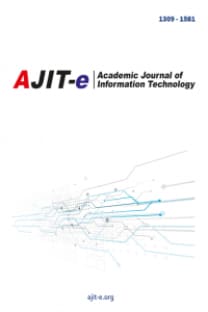Jekyll ve Hyde Çevrimiçi Olduğunda: Transhumanizmi Teşvik Eden Reklamlar Aracılığıyla Özün Tüketimi Üzerine Kritik Bir Analiz
R. Louis Stevenson’un " Dr. Jekyll ile Bay Hyde" adlı ünlü kitabı, eski arkadaşı Dr Jekyll ile kötü muadili bay Hyde arasında geçen benzeri görülmemiş olayları araştıran Londralı bir hukukçunun hikayesini anlatır. Romanın etkisiyle "Jekyll ve Hyde" ifadesi deyimleşmiş ve halk arasında, aşırı uçlarda seyreden ikili doğaya sahip kişilere atıfta bulunurken kullanılır olmuştur. İnsandaki dualistik davranış biçimlerinin altında yatan nedenleri ve umutsuz mükemmellik arayışlarının ardındaki kırılganlıkları irdelemek adınaB.Engel tarafından önerilen 7 tür "Jakyll & Hyde" özelliği, ve bunların reklamlarda transhumanizm penceresinden bireyin tüketilmesi sonrası nasıl ‘üst-insan’ modelini inşa etmede kullanıldığı, transhumanizmi konu alan bir reklama gelen sosyal medya twitleri irdelenerek analiz edilmiştir. Konuyla ilgili gerekli analizlerin yapılabilmesi için seçilen reklama (Verizon, HTC Droid DNA) kalitatif yöntemlerden içerik analizi, göstergebilimsel analiz eşliğindeuygulanmış, aynı zamanda konuya ilişkin ek veri sağlayacak kullanıcı tepkisi ölçmek için de 19 Ocak 2021-27 Ocak 2021 arasında ‘Transhumanizm’ etiketi yapılmış olan tweetler verimadenciliği ile seobotsprogramıüzerinden toplanıp ayıklanarak 108veri ile NVİVO duyguanalizi ile irdelenmiştir.
Jekyll & Hyde Online: A Critical Analysis on Consumption of the Self Through Advertisements Promoting Transhumanism
R. Louis Stevenson’s famous book called “Strange Case of Dr Jekyll and Mr Hyde” is an 1886 novel about a legal worker in London, who investigates the unprecedented events happening between his friend Dr Jekyll, and the evil counterpart Mr. Hyde. This story's impact has been such that the phrase "Jekyll and Hyde" still keeps coming up in conversations even today; referring to persons with an unpredictably dual nature. In order to understand the underlying reasons for the dualistic behavior amongst the humans, and their desperate search for perfection, 7 types of "Jakyll and Hyde" traits proposed by B.Engel will be discussed and analyzed through observing their appearances on advertisements, and how they lead to the consumption of the self in the era of transhumanism today. Qualitative methods, namely content analysis with semiotic undertones, will be applied on the chosen advertisement (Verizon, HTC Droid DNA) to make the necessary analysis on the topic together with a complimentary datamining sentiment analysis on ‘Transhumanism’ hashtag. To analyze the common public opinion on “transhumanism”. Tweets under this hashtag between the 19th of January 2020 – 27th of January 2020 have been gathered by using ‘Seobots’ application, and then the collected data which held 108 tweets on the mentioned hashtag were analyzed by using the NVIVO program for sentiment analysis.
Keywords:
Transhumanism, Advertising, Human, Technology, Digital Social Media,
___
Braidotti, R. (994). Toward a New Nomadism: Feminist Deleuzian Tracks; or, Metaphysics and Metabolism. Gilles Deleuze and the Theater of PhiLosophy (eds: Boundas, C. and Olkowski, D.), ‘New York: Routledge, 159-186Bukatman, S. (1993). Terminal Identity: The Virtual Subject in Postmodern Science Fiction. UK: Duke University Press
Engel, B. (2011). The Jekyll and Hyde Syndrome: What to Do If Someone in Your Life Has a Dual Personality- or If You Do. USA: John Wiley & Sons Publishing
Fauble, B. (2018). "The Rise of AI: Why the American Workforce Must Inevitably Change," Paideia: Vol. 5, Article 15, 98-116.
Haraway,D. (1985). Simians, Cyborgs, and Women: The Reinvention of Nature. USA: Routledge Publishing
Leonhard, G. (2018). Teknolojiye Karşı İnsanlık: İnsan İle Makinenin Yaklaşan Çatışması. İstanbul: Siyah Kitap
Mc Luhan (2002), The Gutenberg Galaxy: The Making of Typographic Man. Canada: University of Toronto Press
Schutte, N. S., Stilinović, E. J. (2017). Facilitating empathy through virtual reality. Springer Onine:https://static1.squarespace.com/static/5d423a9a4416f400014a007a/t/5e214312a917cc6d1499b46a/1579238170754/Facilitating-Empathy-Through-VR.pdf (20.01.2020)
Singh, S. (2017). Transhumanism and the Future of Humanity: 7 Ways the World will Change by 2030. Forbes Magazine: www.forbes.com/sites/sarwantsingh/2017/11/20/transhumanism-and-the-future-of-humanity-seven-ways-the-world-will-change-by-2030/?sh=7a6f58ef7d79 (20.12.2020)
Stevenson, R.L. (1886). Strange Case of Dr Jekyll and Mr Hyde. London: Longmans, Green and co.
Thomas, M.E. (2013). How to Spot a Sociopath. Psychology Today. UK: Sussex Publishers
Toffoletti, K. (2007). Cyborgs and Barbie Dolls: Feminism, Popular Culture, and The Posthuman Body. UK: I.B Tauris
Wolyniak, J. G. (2015). Progress and Progressio: Technology, Self-Betterment, and Integral Human Development. Journal of Moral Theology (ed. Caccamo, J.F. and McCarthy, D.M). Volume 4, Number 1: Technology Paperback. USA: Wipf & Stock Publishing, 36-64
- Yayın Aralığı: Yılda 4 Sayı
- Yayıncı: AKADEMİK BİLİŞİM ARAŞTIRMALARI DERNEĞİ
Sayıdaki Diğer Makaleler
Sağlık Bilgi Sistemi Değişim Direnci Değerlendirmesi
Alaattin PARLAKKILIÇ, Nevzat ÜNALAN
Sümeyra BOYDAK, Yusuf Yalçın İLERİ
Büyük Veri (Big Data)’nin Yapay Zekâ Uygulamalarında Toplumsal Sınıflandırmaya Yönelik Kaygılar
Türkiye’deki İlk 5 Kategori için Instagram Fenomenleri Analizi
